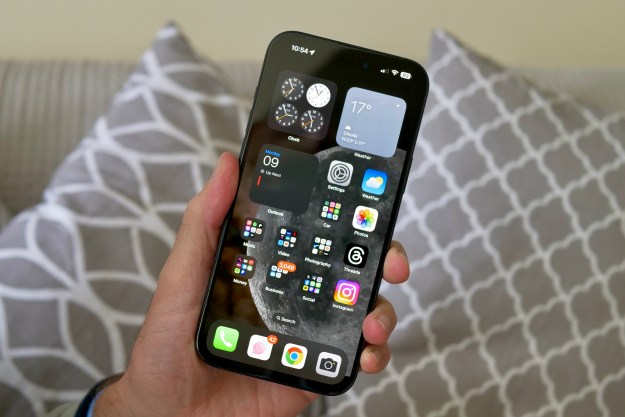Update, June 23, 2020: As of Apple’s 2020 Worldwide Developer Conference, the bug reported here appears to be fixed. Tommy Mysk told Digital Trends that Apple has patched the problem according to his recommendations: by adding an alert when an app has read their clipboard. Apple did not respond to a request for comment.
Original text:
Two software developers, one based in Canada and the other in Germany, say they’ve discovered a flaw in the copy-paste system of Apple’s iOS that could leave iPhone and iPad users’ information vulnerable.
Right now, Apple assumes that when you copy information from an app, the next app you open will be where you want to paste that information. As such, Apple gives the active app that is running in the foreground of your phone access to the operating system’s “pasteboard,” which is essentially short-term memory for all the stuff you’ve copied.
The problem, as outlined by Tommy Mysk and Talal Haj Bakry, is that people get distracted, and open up apps in before pating that information in the desired app. Maybe they get a notification, or maybe they suddenly remember something else they’re supposed to do and forget about what they’ve just copied (attention spans are notoriously short these days).
You #CopyPaste a lot on your iPhone and iPad?
Well, we documented how a malicious app can steal your private data from the clipboard.@Apple doesn’t think it’s a problem!What do you think?
Read the full article at https://t.co/IzHClZxFw1 pic.twitter.com/Y1eXHNs8qM
— Mysk (@mysk_co) February 24, 2020
Mysk and Bakry maintain that every single app a user opens on an iPhone will have access to your pasteboard, and can even write or rewrite on it. This also applies to any widgets that Apple users have running in their “Today View” panels on their phones or iPads — those can also see your pasteboard.
“It can read anything I have in the pasteboard: Photos, PDFs, texts, passwords, and whatever data type you can copy,” Mysk told Digital Trends. “This revelation was shocking to me. It was the reason that pushed me to write a demo app, document the work, and send it to Apple.”
Testing their theory
Mysk and Bakry wrote an app called Klipboard Spy to demonstrate the function. They demonstrated how copying a photo made the photo’s metadata available to Klipboard Spy, including the location where the photo was taken.
If you copy-paste a password, or someone’s bank account number, or any sort of vulnerable personal information, other apps might be able to see this information — apps that you might not necessarily want to have that access. A malicious actor, with enough speed, could theoretically rewrite that bank account information saved in the operating system and reroute the money to a different account.
Let’s say, hypothetically, that there’s a popular app with some shady connections to a certain foreign government on your phone, and on the way between copying a picture and sending that picture to your friend, you open up this other app — that app would be able to see where you’ve been via that photo’s metadata.
This also applies to what’s called the “Universal Clipboard,” which Mysk clarified is a shared pasteboard that is accessible to all Apple devices that use the same Apple ID. If you have a malicious app running in the foreground of your phone and copy-paste something on your computer, the app can see what you’re pasting onto your computer.
The latest version of iPadOS allows a user to set their widget panel to be always visible. This means it’s always active and those apps can see your copy-pastes on all your devices that are linked to your Apple ID. “If you have a malicious widget on top of your Today View, it will always be able to read the pasteboard every time you quit an app,” Mysk said.
“I cannot understand why a widget should have access to the pasteboard. I’m sure there are good scenarios, but as a security expert, I wouldn’t allow it to begin with — at least, not without informing the user,” Mysk said.
Apple responds
Apple did not respond to a request for comment, but according to Mysk, he sent in an official notice on January 2 to Apple saying that he and his partner Haj Bakry had found this flaw. Apple responded on February 6 and, according to Mysk, said that their assessment had concluded there were no risks and supplied a few solutions. Mysk wouldn’t reveal details of the exchange with Apple, but he thought their ideas were paltry at best.
“We presented multiple examples of functioning methods to set up the environment for any attacker to abuse the data,” Mysk said. They provided remedies that are sloppy and don’t fix the issue.”
The problem is that the settings that enable this data leakiness are often the default settings that most users don’t know about, or don’t bother changing, Mysk said. “Why should we not shift the policy from ‘trusting developers’ to ‘user controls it all?” he asked.
For example, he continued, a user can disable the Universal Clipboard, if they know how. “But it is activated by default and most users don’t bother to disable it,” he added.
The good news is a person can mitigate a lot of this simply by disabling locations on photos and being fastidious about what apps are open. But Mysk wanted Apple to take more responsibility.
He pointed to the fact that Apple has changed its permissions for contacts and photos; it used to be that all apps on your phone had default access to these apps, but now a user has to actively give permission. Mysk said he wants to see similar permissions for the pasteboard, as well as a visual indicator for whenever an app can see the pasteboard, similar to the location arrow a user will see when an app is using your location.
Editors' Recommendations
- iPhone SE 4: news, rumored price, release date, and more
- Here’s how Apple could change your iPhone forever
- Why you should buy the iPhone 15 Pro Max instead of the iPhone 15 Pro
- When will Apple release iOS 18? Here’s what we know
- iPhone 16: news, rumored price, release date, and more




